Recent garden moths

I've been largely negligent as far as recording the garden moths here in Banstead this year. The MV has rarely been operated, and I don't really know why. However, with the recent heat, and with it the accompanying muggy nights, I have been stung into action. Migrant wise it has been the expected fayre - a few Silver Y, xylostella, ferrugalis and noctuella . Tree-lichen Beauty, White-point, and Jersey Tiger are all present and correct still. A few Maiden's Blush (there has been some forum discussion that some of these might be migrants, but I usually record a few here every summer). This morning saw the years first Orange Swift (top) and a micro that I have not knowingly recorded before, even though it is very common, Celypha lacunana (left). As always, I am open to correction.









